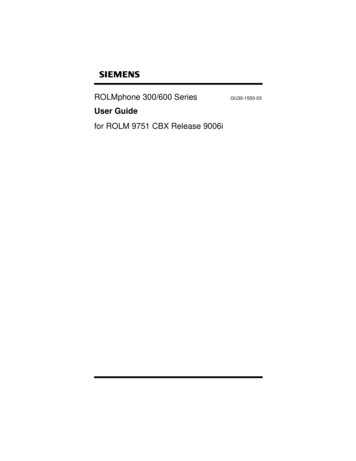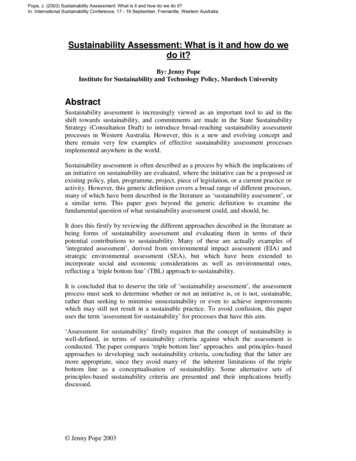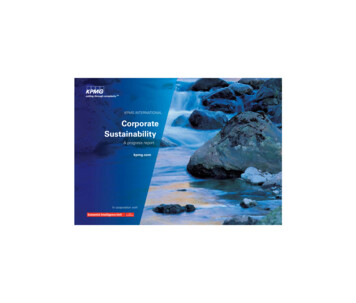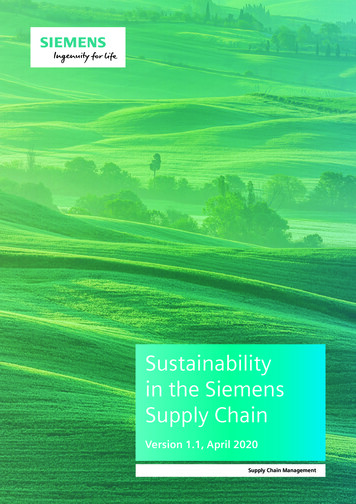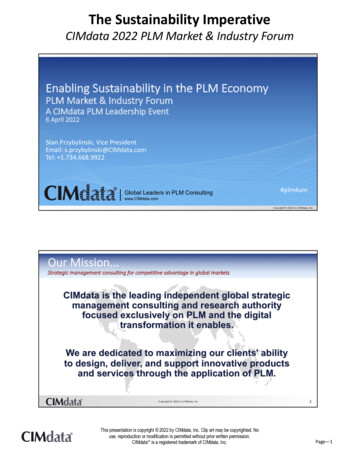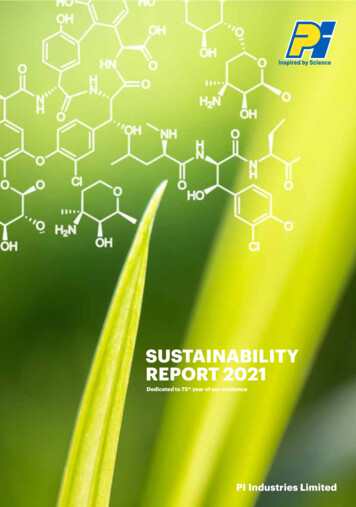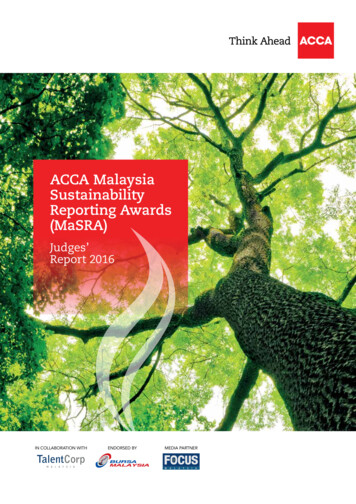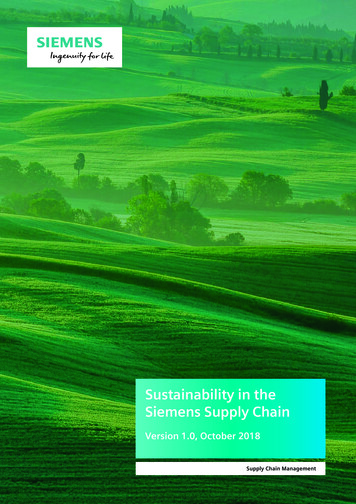
Transcription
Sustainability in theSiemens Supply ChainVersion 1.0, October 2018Supply Chain Management
ContentsChapter 1Siemens Values and Legal Requirements4Chapter 2Code of Conduct for Siemens Suppliers6Chapter 3Risk Awareness8Chapter 4Data Transparency9Chapter 5Suppliers’ Ready-for-Business11Chapter 6Risk Exposure12Chapter 7Risk Detection17Chapter 8Consequences19Chapter 9Company’s Responsibility20Table of ContentsSustainability in the Siemens Supply Chain
“As soon as a company transferssome of its reputational risk, corporate social responsibilityand environmental impact elsewhere, it must tackle SupplyChain Management as one of itsmost pressing concerns.”Dr. Klaus StaubitzerChief Procurement Officer
Chapter 1Siemens Values and Legal RequirementsSiemens’ sustainability initiatives are an essential aspect of successfully implementingthe Siemens Strategy Program Vision 2020 . Our understanding of sustainability isfully based on our company values – responsible, excellent, innovative. At Siemens, wedefine sustainable development as the means to achieve profitable and long-termgrowth. In doing so, we align ourselves with the goals of the UN’s 2030 Agenda for Sustainable Development and the OECD Guidelines for Multinational Enterprises.According to the UN Global Compact, the “supply chain can make a significant impactin promoting human rights, fair labor practices, environmental progress and anti- corruption policies”. Some of the biggest contributions can be made on the UnitedNations Sustainable Development Goals (SDG), especially regarding SDG 8 on DecentWork and Economic Growth, which among other things addresses labor issues, andSDG 12 on Responsible Consumption and Production. SDG 12 specifically calls on companies to work to adopt sustainable practices and increase reporting on their progresstoo. Efforts can be made to address poor working conditions, ranging from minimumwage violations to extreme occupational hazards, and eradicate all forms of forcedlabor and child labor. Unhealthy workplaces can be cleaned up.Siemens’ purchasing volume equals roughly half of our total revenue from some 90,000suppliers in around 150 countries. This brings an enormous responsibility ensuringHuman Rights, Employees’ Health & Safety and Environmental Protection at all our suppliers worldwide as we claim: “We only do business with clean partners”.Within the recent years numerous pieces of legislation were published and require ourabsolute attention. Besides others, EU law on environmental protection and humanrights came into effect as well as legislation in USA, UK, France, Denmark, Australia,and Germany.1. Siemens Values and Legal RequirementsSustainability in the Siemens Supply Chain4
Some examples:– European Union: Regulation concerning the Registration, Evaluation,Authorization and Restriction of Chemicals (REACh), Regulation concerningRestriction of Hazardous Substances (RoHS), Timber Regulation,F-Gases Regulation, Conflict Minerals Regulation– United States of America: Dodd-Frank Act, Sec 1502 “Conflict Minerals”,California Transparency in Supply Chains Act of 2010, Business Supply Chain Transparency on Trafficking and Slavery Act of 2015– Germany: Requirements out of the National Action Plan on ensuringHuman Rights in the Supply Chain– United Kingdom: Modern Slavery Act 2015– France: Loi de VigilanceSiemens Supply Chain Management (SCM) has to ensure that Siemens meets all theserequirements. SCM therefore has implemented various procurement processes.This Sustainability in the Siemens Supply Chain Brochure shall internally help to understand and fulfill all sustainability requirements within the business relations with oursuppliers. Externally it shall inform our stakeholders on our Supply Chain Sustainabilityefforts.51. Siemens Values and Legal RequirementsSustainability in the Siemens Supply Chain
Chapter 2Code of Conduct for Siemens SuppliersThe “Code of Conduct for Siemens Suppliers and Third Party Intermediaries” and thereonbased company-wide, mandatory requirements and processes ensure the effectiveestablishment of the specified environmental, compliance and labor standards acrossall countries of operations.The Code of Conduct covers the following requirements:– Legal compliance– Prohibition of corruption and bribery– Fair competition, anti-trust laws and intellectual property rights– Avoid conflicts of interest– Respect for the basic human rights of employees– Prohibition of child labor– Health and safety of employees– Environmental protection– Promote compliance to Code of Conduct in own supply chain– Avoid use of Conflict Minerals (part of Responsible Minerals Sourcing)The Code of Conduct commitment processes for suppliers are Siemens-wide mandatory:– To become “Ready-for-Business” all new suppliers have to commit to the Code of Conduct. The commitment must be given during the supplier’s registration processin our global procurement application SCM STAR.– All new and extended procurement contracts have to include the Code of Conductcommitment, a paragraph on Supplier Self-Assessment and Audit-right and a specifictermination clause in case of major breach of our Code of Conduct requirements.– All worldwide available Siemens Conditions of Purchase have to include the principles of the Code of Conduct.2. Code of Conduct for Siemens SuppliersSustainability in the Siemens Supply Chain6
Siemens requires all its suppliers to promote the implementation of the requirementsof the Code of Conduct in their own supply chain.As companies are facing the challenge of complying with a multitude of different environmental and labor standards, we intend to avoid a "code mania" and we are striving to reduce the duplication of efforts at suppliers and customers while maintaining our high environmental and labor standards. We have, therefore, introduced a corporate managed procedure for accepting industry-specific codes as equivalent tothe requirements of our Code of Conduct, as well as those of suppliers and associations, when their requirements comply with our own requirements.72. Code of Conduct for Siemens SuppliersSustainability in the Siemens Supply Chain
Chapter 3Risk AwarenessSiemens has implemented a system of interconnected processes and tools to ensurefull transparency and awareness for our purchases and for our supply chain risks &opportunities. It is important not only to implement “stand-alone” processes for different risk areas but to develop a comprehensive system covering all Code of Conductrequirements. This, however, is a lengthy and continuous process which – step-by-step– adds new elements. We are working constantly on improving our Sustainability in theSupply Chain processes by considering the highly diverse and complex requirementsby laws, customers, stakeholders and NGOs.Critical suppliers can be identified in various ways. We have implemented processes tocover supplier risks according to our Code of Conduct categories. This provides a clearstructure and walks us through all legislative requirements we must meet in the different regions we procure.Examples for specific risk categories are suppliers:– based in higher risk countries– falling under general supplier quality management aspects– with high purchasing volume– that are requested from customers– with forced and compulsory labor risks and risk for child labor– with health and safety risks, mainly working in building business (“contractors”)– providing products falling under the REACh / RoHS legislation– providing products or services with a high carbon footprint– providing products relevant concerning responsible mineral sourcing3. Risk AwarenessSustainability in the Siemens Supply Chain8
Chapter 4Data TransparencyData transparency is a prerequisite for all procurement activities and a must for fulfilling sustainability requirements in the supply chain and its legal obligations.Our Siemens-wide implemented procurement applications “SCM STAR” (STrategy AndRealization) and “SCM CoRe” (Controlling and Reporting) provide all Siemens procurement data centrally. Based on the supplier’s risk categorization all relevant suppliers inone or more critical groups can therefore be identified.In order to systematically leverage the potential of the procurement function in termsof opportunity and risk management across all our businesses and regions, standardized extraction and central provision of all procurement-relevant information is crucial.For this purpose, all relevant procurement information is administered in a centraldatabase where the data is aggregated and made available to individual users (Controllers, Buyers, Commodity Managers, Purchasing Councils, Project ProcurementManagers).SCMCoRe contains – amongst others – following data on all purchases of goods andservices:– Supplier information (incl. registered name, address and country)– Identifier for Account (IfA): Internal unique identification number for suppliers– Commodity Code (ESN): Internal 3-digit ESN classification key forall purchased goods and services– Purchasing VolumeSCM STAR is a cloud-based Siemens procurement application integrating areas of Supplier Management, Contract Management and Sourcing where all employees withprocurement responsibilities have access to. SCM STAR has the following benefits:– Reduced complexity of processes based on market standards– Transparency and end-to-end coverage of Source-to-Contract (S2C) processes– One single S2C cockpit for buyer and supplier interaction– Modular and integrative solution4. Data TransparencySustainability in the Siemens Supply Chain9
This system includes all necessary information for strategic procurement and our supplier management processes, such as qualification, evaluation, risk & opportunitymanagement as well as development of suppliers. In addition, it also provides functions for electronic information exchange with suppliers including the CorporateResponsibility Self-Assessment.104. Data TransparencySustainability in the Siemens Supply Chain
Chapter 5Supplier’s Ready-for-BusinessWe have implemented a mandatory, Siemens-wide Supplier Management Process toensure that we collaborate with the best suppliers. All relevant aspects in relation toprocurement, quality, logistics and technology have to be considered, as well as strategy, innovation, potential and risks. Innovations and potential procurement options aremonitored regularly along with important market and technology trends.Especially at the beginning of a potential collaboration with a supplier it is important toverify suppliers’ commitment in order to act in the sense of our values and according toour requirements.Therefore, suppliers nominated on basis of preselection must clearly provide a commitment of their obligation to fulfill all minimum requirements. This includes the suppliers' agreement to abide by the Siemens Code of Conduct. Additionally, within the Supplier Qualification process, suppliers have to fulfill various requirements depending ondefined triggers, e.g. country of location or kind of delivered products and services.Only if the supplier has successfully completed the registration and qualification processes, it is assigned with the status “Ready-for-Business” (R4B) and can be utilizedby Siemens buyers.5. Supplier’s Ready-for-BusinessSustainability in the Siemens Supply Chain11
Chapter 6Risk ExposureWith such a large and geographically dispersed supplier network, Siemens cannotmaintain the same level of oversight for every supplier with r easonable effort.For example, it would be impossible to perform site audits everywhere. Therefore,we have established risk analysis procedures for all risk categories to systematicallyidentify potential risk suppliers within each commodity or country. In doing so, weimplemented risk based processes to secure our supply chain’s sustainability risks.Additionally, other processes within SCM, Compliance, Environment, Health and Safetyor on re gional level are in place for very specific internal topics or legislative demands.12Suppliers based in higher risk countries – Corporate Responsibility Self-AssessmentWhen based in a higher risk country, the supplierhas to pass a Sustainability Self-Assessment inorder to become a Siemens supplier. The moredetailed process is described under Chapter “RiskDetection – Corporate Responsible Self- Assess ment”.All Code ofConduct requirementsin scope6. Risk ExposureSustainability in the Siemens Supply Chain
Suppliers falling under general supplier quality management aspectsSustainability is part of our quality requirementtowards our purchased products and services. Generally, supplier audits serve to check, monitor andcontinuously improve suppliers' quality capability.Supplier quality audits also include questionsabout sustainability that cover the aspects andrequirements of the Code of Conduct.All Code ofConduct requirementsin scopeSuppliers with high purchasing volumeMany of our “high purchasing volume suppliers”have strong sustainability processes and controlling mechanisms due to their own size and economical importance and seem less critical. But theyare sensitive partners which have high impact incase of sustainability failures due to their largenumber of (possibly affected) employees or to thesurrounding community due to their economicpower. We often use the External SustainabilityAudit for in-depth controlling of our high-volumesuppliers.13All Code ofConduct requirementsin scopeForwarding sustainability requirements into 2ndtier suppliers: A main aspect conducting audits athigh volume suppliers is that they mostly have alarger supplier base. An External Sustainability Audit enables us to ensure that ourstrong sustainability requirements will be forwarded to the supplier’s supply base(our 2nd tier suppliers).6. Risk ExposureSustainability in the Siemens Supply Chain
Customer requested suppliers –“Correct Purchasing” RegulationsSuppliers requested by the customer are categorized as critical. The Siemens internal “Correct Purchasing” Regulations describe the handling of thisspecific customer demand in its “Dos and Don’ts”which were developed together with the Siemens Compliance Organization: Independent of the customer’s preference for a specific supplier, alternative offers have to be obtained by Siemens SCMand compared with the customer request. In caseof negative deviation (price, quality and sustainability risks) the customer should be contacted andthe situation must be discussed, jointly decidedand documented in the project files.Corruption/ bribery requirementsin scopeSuppliers with forced/compulsory laborrisks and risk for child laborProtecting the weakest in our supply chain must beour most important duty. As an element of our Digitization Program, we developed an electronicsystem which has been able to dig into more specific Human Rights topics in our supply chain.While earlier processes mainly used high levelcountry and industry specific risk factors, the newmodel will include far more detailed informationprovided by national and international resourcesand will be updated constantly. It is currently in atesting phase.14Human rights requirementsin scopeAfter identifying the relevant risk suppliers, theprocess will be similar to the other approacheswhich are described in this brochure: using our detection modules for (on-site) checks,spotting deficiencies and reacting immediately.6. Risk ExposureSustainability in the Siemens Supply Chain
Suppliers with Health & Safety risks, mainlyworking in building business (“contractors”)The assurance of employees’ Health & Safety during building business is one of our most importantsustainability requirements. We decided to question new contractors at the earliest possiblemoment regarding their safety performance. Siemens SCM together with Siemens EHS (Environment, Health & Safety) experts developed an Occupational Health & Safety (OHS) questionnairewhich has to be filled in during the supplier selection (on-boarding) phase. Although ensuring allSiemens minimum requirements, the OHS questionnaire can differ within the Siemens Businessesand Regions as different crafts/projects and locations and their different dangers might lead to specific questions. EHS experts alone, without the influence of e.g. SCM or ProjectManagement (most building works are executed in our projects), decide if a contractorqualifies to work on Siemens project sites. This process is the first step in a line of OHSmeasures.Suppliers providing products falling underthe REACh / RoHS legislationNational and international legislation pertaining toenvironmental protection include, among others,restrictions and prohibitions regarding the use ofsubstances that could be hazardous to humans orthe environment like the "RoHS" (“Restriction ofHazardous Substances”) directive or the necessityof information and registration requirements forcertain substances contained in products as stipulated by the "REACh" Regulation (Registration, Evaluation, Authorization and Restriction of Chemicals). Based on our Siemens-wide procurementdata base (see chapter “Data Transparency”), Siemens SCM together with our Environment, Healthand Safety (EHS) co lleagues have implemented asystematic identifi cation which allows us to approach all relevant suppliers. “Relevant”are those sup pliers where the risk of declarable substances (according to the REACh/RoHS legislation can occur in their purchased products. We contact all those suppliersto ensure avoidance of any restricted substances according to the “List of DeclarableSubstances (LoDS)”. More details on this detection module is described in chapter “Riskdetection – substance commitment”.6. Risk ExposureSustainability in the Siemens Supply ChainHealth& Safety requirementsin scope15Environmentalprotectionrequirementsin scope
Suppliers providing products or serviceswith a high CO2 footprintIn 2016, the Siemens Board published the Siemenstarget to be Carbon-Neutral by 2030 (50% reduction by 2020). Supply Chain Management (SCM) isinvolved in many areas to ensure reaching this target. On the Supply Chain side, we are continuallyworking on CO2 transparency and are in close cooperation with suppliers in order to reduce our suppliers’ CO2 footprint.In 2017, we started our “Carbon Emissions@Suppliers” project cooperating with an external serviceprovider. Together we managed to develop an economic model which identifies the CO2 footprint ofall our Siemens suppliers. Based on this model, weare currently building up a system to approach our high emission CO2 suppliers. A first survey demanding more detailed direct supplier information on their CO2 footprint wasconducted centrally with more than 5,000 suppliers causing approximately half of ourScope 31 CO2 footprints. Step-by-step, we seek to sensitize our supplier base regardingthe importance of more CO2 efficient production.Suppliers providing products relevant inregard to Responsible Minerals Sourcing(incl.“Conflict Minerals”)Siemens has rolled out a uniform and enterprisewide process (“Supply Chain Due Diligence”) todetermine the use, source and origin of the relevant minerals in our supply chain (e.g. ConflictMinerals) which originate from Conflict-Affectedand High-Risk Areas and are affected by risksdefined in Annex 2 of the OECD Due Diligence Guidance. This includes the “Responsible MineralsAssurance Process” (RMAP) as part of the “Responsible Minerals Initiative” (former “Conflict FreeSourcing Initiative”). We work closely with our suppliers to support us in carrying out these steps.Where necessary, we work with suppliers in orderto remediate risks and perform additional due diligence so that we can continue tosource responsibly, building on established m anagement processes.Scope 1: All direct Greenhouse Gas (GHG) emissions by a company; Scope 2: indirect GHG emissions from consumption of purchased electricity, heat or steam; Scope 3: other indirect emissions, such as the extraction and production ofpurchased materials and fuels, transport-related activities in vehicles not owned or controlled by the reporting entity,electricity-related activities (e.g. T&D losses) not covered in Scope 2, outsourced activities, waste disposal, etc.16. Risk ExposureSustainability in the Siemens Supply ChainEnvironmentalprotectionrequirementsin scope16Conflict minerals &responsibleminerals sourcingrequirementsin scope
Chapter 7Risk DetectionControlling risks need not necessarily lead to audits. There are alternative possibilitiesfor effective detection and development. We, therefore, implemented a set of inter connected controlling mechanisms which are customized towards the respective risk.Following exemplary processes should illustrate our efforts:Corporate Responsibility Self AssessmentsWe found that sustainability topics are observed or understood in different ways in different regions/countries. Therefore, we have categorized our suppliers according totheir physical location: the categorization for higher risk status is mainly based onOECD countries membership combined with the result in the Transparency Inter national Corruption Perception Index. Suppliers with a respective purchasing volumelocated in a higher risk country have to conduct our Corporate Sustainability SelfAssessment. Based on the answers we decide if the candidate fulfills our requirements,has to set up development measures or has to be rejected.Supplier AuditsSupplier Audits basically focus on quality oriented risk mitigation and are conducted bySiemens Quality Management via on-site visits. Within the scope of supplier quality,adherence to the requirements of the Code of Conduct is checked. The respective ESG(Environmental, Social and Governance) questions are integrated in the Supplier AuditQuestionnaire. As a result, the suppliers receive a detailed report including findingsand measures to improve the situation.7. Risk DetectionSustainability in the Siemens Supply Chain17
External Sustainability AuditsThe External Sustainability Audits are conducted by assigned internationally recognized sustainability auditing companies. Using external partners ensure a thoroughand independent assessment of the implementation of our requirements and identifyany potential risk in the supplier's practices.The audits follow a standardized process and generate a corrective action plan to thesupplier, not only covering the implementation of requirements but also providing recommendations for the further development of sustainability practices.Substance CommitmentIn order to adhere with national and international legislation and their requirements oncertain substances (besides others REACh and RoHS), potential relevant suppliers arecontacted and have to declare whether their products delivered to Siemens contain anyrestricted substances according to the “List of Declarable Substances (LoDS)”. Therefore,they have to commit to declare such content to Siemens.Responsible Mineral SourcingWe implemented an annual Supply Chain Due Diligence process. By surveying our suppliers with Responsible Minerals Initiative’s “Conflict Minerals Reporting Template”(RMI’s CMRT), we identify all smelters & refiners in our supply chain. All eligible smeltersor refiners will be reached out and audited via RMI’s “Responsible Minerals AssuranceProcess” (RMAP) where Siemens is a member company and actively supports thesmelter engagement.Beyond all the globally defined risk detection processes Siemens has a major advantagebecause the world-wide Siemens organization is based in most countries in which oursuppliers are located. This means that our local buyers are in the optimal postion toknow their suppliers best and they can visit suppliers on-site during their negotiationsand general meetings, for example.7. Risk DetectionSustainability in the Siemens Supply Chain18
Chapter 8ConsequencesResults of the different detection modules with minor deviations and suspicion of serious deviations trigger a corrective action process.If non-conformance with our Code of Conduct is identified, Siemens will work togetherwith the supplier to mutually agree on corrective actions which have to be implemented within an agreed time frame. If all efforts to develop the supplier remainun successful, whether due to lack of willingness or inability, Siemens reserves theright to terminate the business relationship and phase out the supplier.Since fiscal 2015, we have implemented the tightened process of the “Central WarningMessage” which ensures a faster and more effective reaction to major breaches of theCode of Conduct requirements: All local blocking now has to be reported to CorporateSCM. There, the necessity of a worldwide blocking is decided centrally. It allows us toblock suppliers for all Siemens organizations worldwide at short notice.8. ConsequencesSustainability in the Siemens Supply Chain19
Chapter 9Company’s ResponsibilityEstablishing Sustainability in the Supply Chain (e.g. Human Rights, Health & Safetystandards, Environmental Protection, fighting against Corruption) shall not be a secretinternal company policy – it is not implemented to gain an economical advantageagainst competitors. It must be shared publicly as an inspiration to jointly work for abetter life for all who take part in our interconnected world.It is a company’s responsibility – or less abstract: every buyer’s responsibility –to ensure that all measures offered are used to improve the lives of our suppliers'employees and the conditions in the societies in which they are based.9. Company’s responsibilitySustainability in the Siemens Supply Chain20
21
Editor:Global Services, Supply Chain Management, GovernanceFramework, Procurement StandardsSustainability in the Siemens Supply ChainVersion 1.0Changes or exceptions to be made based on this publicationmust be coordinated with GS SCM GF PST.Layout:Digitas GmbHThierschstr. 11-1580538 Münchenwww.digitas.de
Siemens Supply Chain Management (SCM) has to ensure that Siemens meets all these requirements. SCM therefore has implemented various procurement processes. This Sustainability in the Siemens Supply Chain Brochure shall internally help to under - stand and fulfill all sustainability requirements within the business relations with our suppliers.



